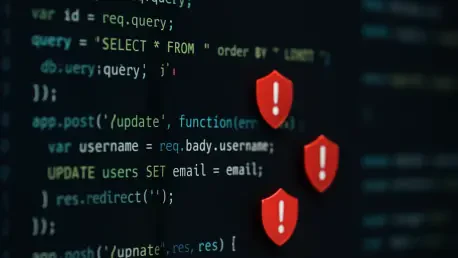In a digital landscape where a single breach can dismantle a company’s reputation overnight, a shocking reality emerges: developers are knowingly releasing vulnerable code at an alarming rate. Picture a ticking time bomb embedded in the software that powers critical systems—hospitals, banks, and governments—all while those responsible for building it are fully aware of the flaws. This unsettling trend, fueled by the pressure to deliver faster, raises urgent questions about the balance between innovation and security in an era of relentless cyberattacks.
Why Developers Push Flawed Code Despite Escalating Threats
The drive to release software quickly often overshadows the need for robust security. Many development teams operate under tight deadlines, with business leaders prioritizing market competitiveness over ironclad protection. This rush to deploy, even when vulnerabilities are known, has become a calculated risk for 80% of firms, a figure that reflects a stark choice to gamble with digital safety.
Beyond deadlines, resource constraints play a significant role. Smaller organizations, in particular, may lack the budget or expertise to address every flaw before launch, leading to a mindset of fixing issues post-release. This approach, however, leaves systems exposed during critical early usage periods, amplifying the potential for exploitation by malicious actors.
The consequences of such decisions are not theoretical. With cyberattacks growing in sophistication, the decision to push flawed code is akin to leaving a door unlocked in a high-crime neighborhood. The digital ecosystem now faces unprecedented risks, making this practice a pressing concern for industries worldwide.
The Alarming Surge in Vulnerable Code and Security Breaches
The scale of the problem is staggering, as 98% of companies reported intrusions tied to vulnerable code in the current year. This near-universal experience marks a sharp escalation from previous data, underscoring how pervasive the issue has become. Breaches are no longer isolated incidents but a routine challenge for organizations of all sizes.
What’s more troubling is the frequency of these attacks. The percentage of firms facing four or more breaches annually has nearly doubled, climbing from 16% to 27% in a short span. Each incident weakens defenses further, creating a vicious cycle where attackers exploit compounding vulnerabilities with increasing ease.
This crisis isn’t just about numbers—it’s about impact. A single breach can cost millions in damages, erode customer trust, and trigger regulatory penalties. As the digital economy grows, the stakes of ignoring vulnerable code rise exponentially, demanding immediate attention from both technical teams and corporate leadership.
The Disconnect: Knowing the Risks but Failing to Act
Awareness of security risks is widespread, yet action remains elusive for many organizations. Only 31% of security leaders express confidence in their programs’ maturity, while nearly 20% admit to glaring deficiencies in their frameworks. This gap between understanding the problem and implementing solutions leaves networks dangerously exposed.
A key factor in this inaction is the prioritization of speed and cost over safety. Many firms view security as a secondary concern, opting to release vulnerable code with the intention of patching it later—a risky strategy when attackers often strike within days of deployment. This trade-off, while strategic in the short term, often backfires with long-term consequences.
Emerging threats add further complexity to the challenge. With 35% of companies anticipating software supply-chain compromises in the next 12 to 18 months, and 50% using AI-generated code without adequate governance, the attack surface continues to expand. These modern risks highlight the urgent need for a cultural shift toward proactive security measures.
Insights from the Frontlines: Realities of Software Security
Surveys of over 1,500 professionals, including chief information security officers and developers, reveal a sobering picture of the industry’s struggles. Many respondents acknowledge that security often takes a backseat to other priorities like product deadlines or budget constraints. This candid feedback underscores the human and organizational pressures driving risky decisions.
One anonymized account from a developer illustrates the dilemmfacing an imminent product launch, the team chose to deploy code with known flaws, hoping to address them in a future update. Within weeks, a breach occurred, costing the company significant resources and credibility. Such stories are becoming all too common, reflecting systemic challenges in balancing competing demands.
Expert perspectives further emphasize the scale of the issue. Security specialists note that the rapid adoption of new technologies, often without proper safeguards, exacerbates vulnerabilities. As one industry insider put it, the race to innovate frequently leaves security as an afterthought, a mindset that must change to protect the digital infrastructure.
Practical Solutions to Prioritize Security in Development
Addressing this crisis requires actionable steps that integrate security into every stage of software creation. Establishing robust frameworks, such as mandatory vulnerability scanning within development pipelines, can catch flaws early. Automated tools can flag issues before code reaches production, reducing the likelihood of exploitable weaknesses.
Policies must also adapt to modern challenges. For instance, with half of surveyed firms using AI code assistants, strict guidelines on their use are essential to prevent introducing unvetted vulnerabilities. Similarly, vetting vendors and conducting regular audits can mitigate risks like supply-chain attacks and cloud misconfigurations, which remain top concerns for many organizations.
Empowering teams is equally critical. Training developers on secure coding practices and fostering collaboration between security and development units can bridge existing gaps. By embedding a security-first mindset, companies can innovate without sacrificing protection, ensuring that software remains both cutting-edge and safe from threats.
Reflecting on a Path Forward
Looking back, the journey through the landscape of software security revealed a troubling willingness to compromise safety for speed. Countless organizations paid a steep price for releasing vulnerable code, with breaches becoming a near-universal ordeal. The stark rise in attack frequency and the emergence of new risks painted a grim reality.
Yet, amidst these challenges, actionable paths emerged. Adopting automated tools, enforcing strict policies on AI tools, and prioritizing training offered tangible ways to strengthen defenses. These steps, if embraced widely, could shift the tide against escalating threats.
Moving ahead, the focus must remain on building resilience. Organizations should commit to regular security audits, invest in maturing their programs, and champion a culture where safety is non-negotiable. Only through such dedication can the digital world safeguard itself against the evolving dangers that lie ahead.









